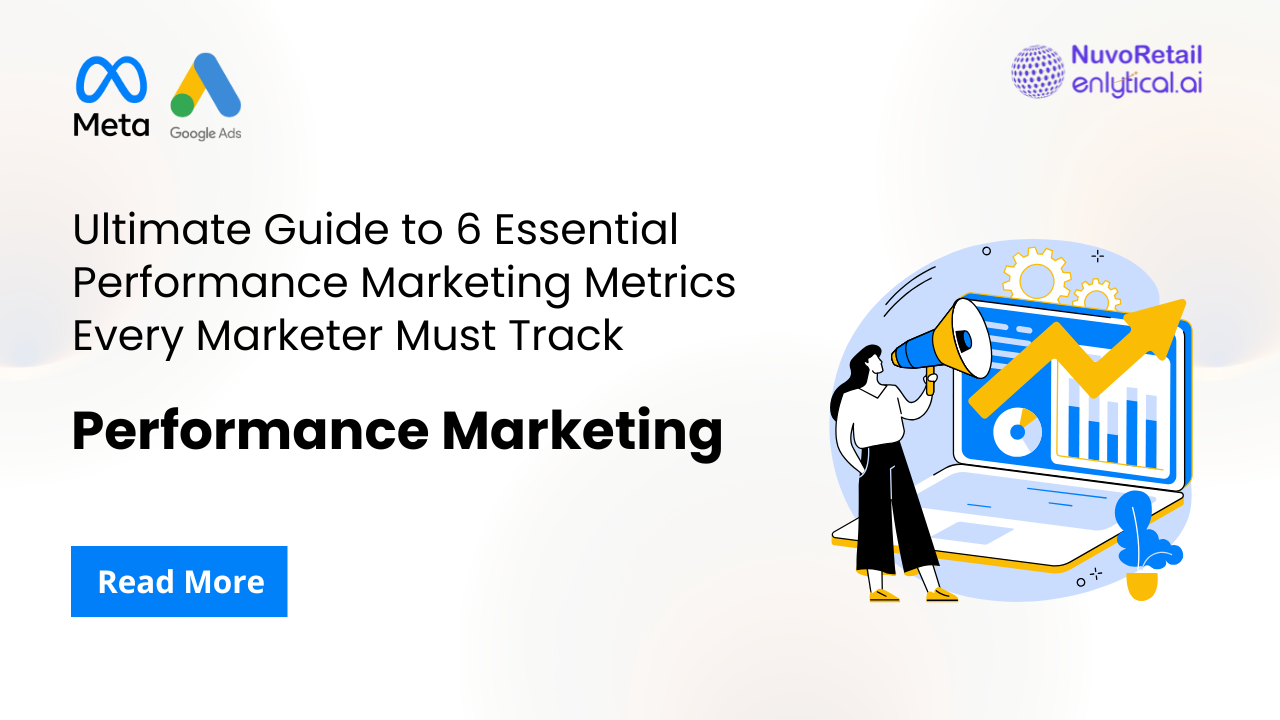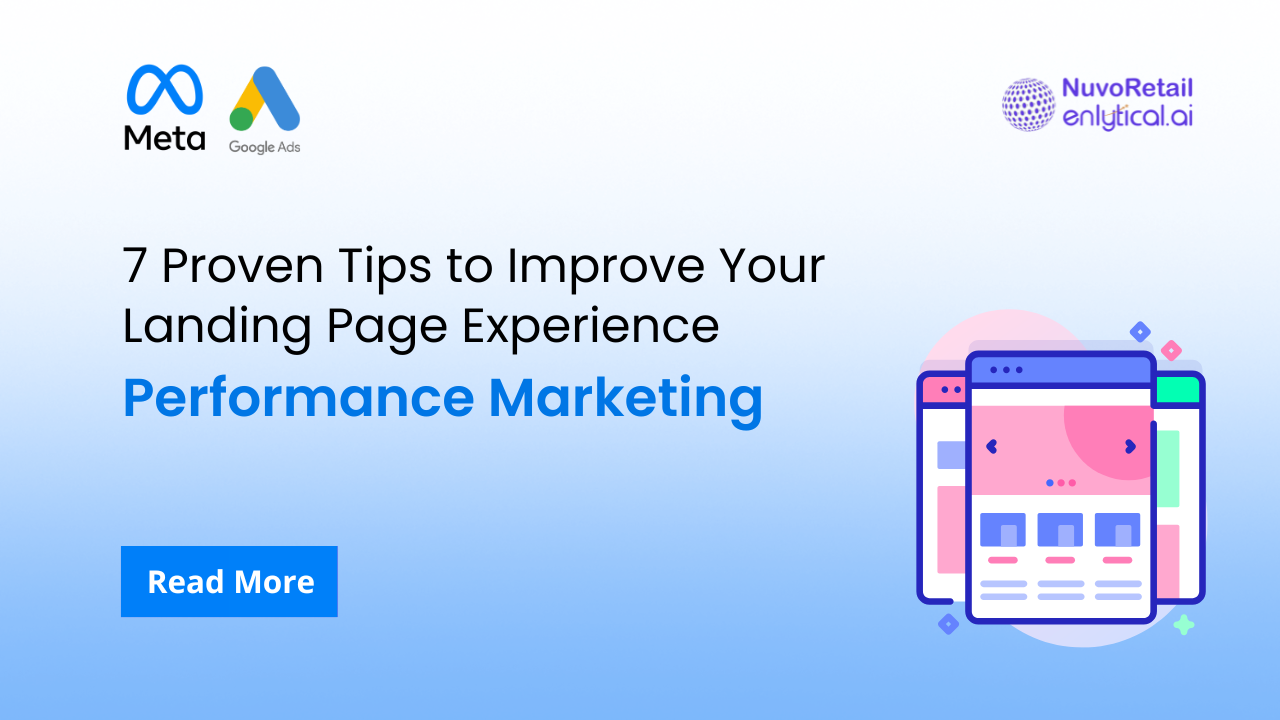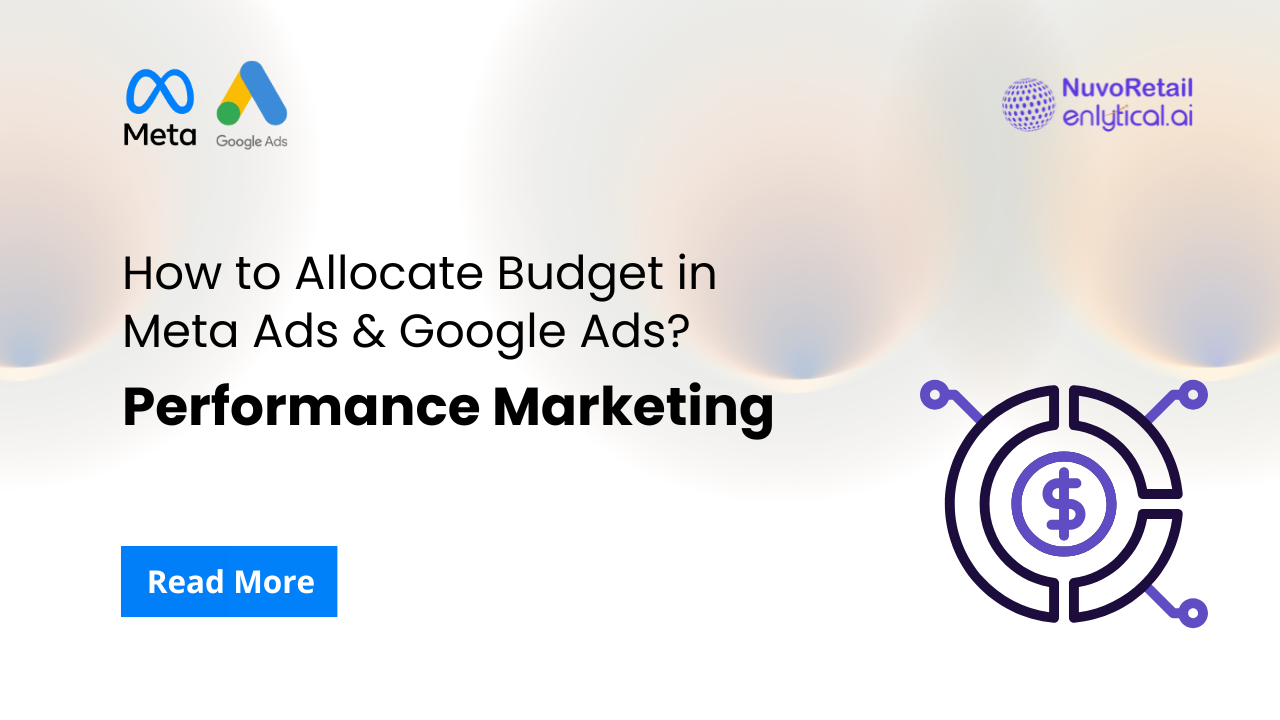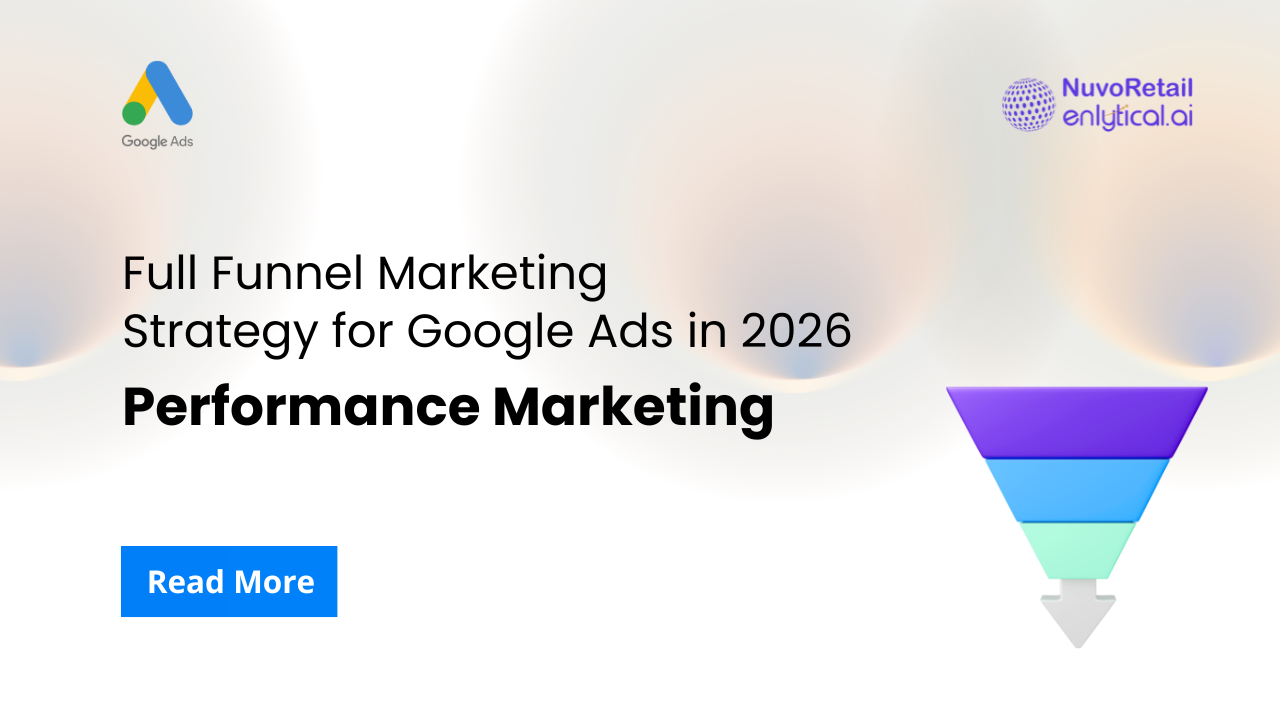Performance marketing has revolutionized how businesses approach digital advertising by focusing on measurable results and data-driven decisions. Unlike traditional marketing methods, performance marketing allows you to track every dollar spent and measure its direct impact on your business goals. Whether you’re running Google ads, managing your Facebook and Instagram ads through Meta ads manager, or launching campaigns across multiple platforms, understanding key performance marketing metrics is crucial for success.
In today’s competitive digital landscape, marketers who master performance marketing metrics gain a significant advantage. These metrics serve as your compass, guiding campaign optimization decisions and helping you maximize return on investment. From small businesses to enterprise-level digital marketing agencies, professionals rely on these fundamental performance marketing metrics to drive growth and profitability.
At NuvoRetail, we provide end-to-end performance marketing services that help brands maximize ROI across platforms like Google Ads, Meta Ads Manager, and more.
Table of Contents
- What is Performance Marketing?
- The 6 Essential Performance Marketing Metrics
- How to Track These Metrics Across Different Platforms
- Common Mistakes to Avoid
- Tools for Performance Marketing Analytics
- Conclusion
What is Performance Marketing?
Performance marketing is a comprehensive digital marketing strategy where advertisers pay only when specific actions are completed. These actions can include clicks, leads, sales, or other predetermined conversions. This approach ensures marketing budgets are spent efficiently, making it particularly attractive for businesses seeking measurable results.
The foundation of performance marketing lies in its accountability. Every campaign element is trackable, from the initial ad impression to the final conversion. This transparency enables marketers to track performance marketing metrics that reveal what’s working and what needs refinement.
NuvoRetail’s performance marketing services are built on the same principles—data-driven decisions, measurable ROI, and continuous optimization—to ensure every marketing dollar delivers impact.
Digital marketing agencies worldwide have embraced performance marketing because it aligns advertiser goals with agency success. When campaigns perform well, both parties benefit, creating a partnership focused on results rather than just activity metrics.
The 6 Essential Performance Marketing Metrics

1. Click-Through Rate (CTR)
Click through rate is one of the most important performance marketing metrics, measuring the percentage of people who click on your ad after seeing it. This metric indicates how compelling and relevant your ad creative is to your target audience.
CTR Formula: (Total Clicks ÷ Total Impressions) × 100
A high CTR suggests your ad resonates with viewers, while a low CTR may indicate issues with targeting, creative, or messaging. Industry benchmarks vary significantly across platforms and sectors.
For Google ads campaigns, search ads typically achieve higher CTRs than display ads due to user intent. Facebook ads and Instagram ads through Meta ad manager often see different CTR ranges based on creative format and audience targeting.
CTR Optimization Tips:
- Test compelling headlines and descriptions
- Use relevant keywords in ad copy
- Implement strong call-to-action phrases
- Ensure ad creative matches landing page content
2. Cost Per Click (CPC)
Cost per click represents the average amount you pay each time someone clicks your ad. Among all performance marketing metrics, CPC plays a crucial role in controlling advertising costs. This metric directly impacts your advertising budget and helps determine campaign profitability.
CPC Formula: Total Cost ÷ Total Clicks
CPC varies based on competition, keyword difficulty, and platform. Google advertising typically sees higher CPCs for competitive keywords, while social media platforms like Facebook advertising may offer lower CPCs but different conversion rates.
Understanding CPC helps optimize bidding strategies and budget allocation. A digital marketing company might lower CPCs by improving Quality Scores on Google ads or refining audience targeting on Meta ads.
CPC Management Strategies:
- Optimize ad relevance and Quality Score
- Use negative keywords to eliminate irrelevant traffic
- Test different bidding strategies
- Focus on long-tail keywords with lower competition
3. Cost Per Mille (CPM)
Cost per mille, also known as cost per impression, measures the cost of 1,000 ad impressions. CPM is particularly important for brand awareness campaigns and display advertising.
CPM Formula: (Total Cost ÷ Total Impressions) × 1,000
CPM campaigns focus on reach and frequency rather than direct response. This metric helps evaluate the cost-effectiveness of brand exposure across different platforms and audiences.
Display ad campaigns often use CPM pricing, making it essential for marketing agencies running awareness campaigns. Instagram advertising and Facebook ads manager provide detailed CPM data for campaign analysis.
CPM Optimization Techniques:
- Target specific demographics and interests
- Test different ad formats and placements
- Optimize for relevant audiences
- Monitor frequency to avoid ad fatigue
4. Cost Per Lead (CPL)
CPL measures the average cost to generate one qualified lead. This metric bridges the gap between clicks and actual business value, making it crucial for B2B companies and service providers.
As part of the broader set of performance marketing metrics, CPL is particularly valuable for service-based businesses.
CPL Formula: Total Cost ÷ Total Leads
Lead generation campaigns require careful tracking from initial click through form submission or contact. A digital marketing agency might track CPL across multiple touchpoints, including Google ads account performance and social media campaigns.
CPL optimization often involves improving landing page conversion rates, form design, and lead qualification processes. This metric helps determine which channels provide the most cost-effective lead generation.
5. Cost Per Acquisition (CPA)
Cost per acquisition measures the average cost to acquire one customer or complete a desired conversion. CPA remains one of the most important performance marketing metrics for evaluating true ROI.
CPA Formula: Total Cost ÷ Total Acquisitions
CPA encompasses the entire customer journey from initial impression to final conversion. This metric helps determine true campaign profitability and guides budget allocation decisions.
Successful CPA optimization requires understanding customer lifetime value and acceptable acquisition costs. Marketing performance improves when CPA remains below predetermined thresholds while maintaining conversion quality.
CPA Improvement Tactics:
- Optimize conversion funnel stages
- Improve landing page user experience
- Test different traffic sources
- Refine audience targeting parameters
6. Return on Ad Spend (ROAS)
ROAS measures the revenue generated for every dollar spent on advertising. Among all performance marketing metrics, ROAS provides the clearest picture of campaign profitability and overall marketing effectiveness.
ROAS Formula: Revenue from Ads ÷ Cost of Ads
A ROAS of 4:1 means you generate $4 in revenue for every $1 spent on advertising. This metric helps determine which campaigns, keywords, and audiences provide the best return on investment.
ROAS analysis should consider customer lifetime value, repeat purchases, and attribution models. A comprehensive view helps optimize long-term profitability rather than just immediate returns.
How to Track These Metrics Across Different Platforms
Different advertising platforms provide varying levels of metric visibility and tracking capabilities. Understanding each platform’s strengths helps create comprehensive measurement strategies.
Google Ads Account Tracking: Google ads campaign data provides detailed insights into search ad performance, display advertising results, and shopping campaign metrics. The platform offers robust conversion tracking and attribution modeling.
Meta Ads Manager Analytics: Facebook ads manager and Meta ad manager provide comprehensive social media advertising metrics. Instagram ads and Facebook advertising data combine to show cross-platform performance.
Third-Party Analytics Tools: Tools like SEMrush, HubSpot, Google Trends and more offer additional insights beyond native platform reporting. These solutions help correlate performance marketing metrics with broader business objectives.
Unified Tracking Approaches: Successful digital marketing services often implement unified tracking systems that aggregate data across platforms. This approach provides holistic performance views and identifies cross-channel optimization opportunities.
Common Mistakes to Avoid
Many marketers make critical errors when tracking and optimizing performance marketing metrics. Understanding these pitfalls helps avoid costly campaign mistakes.
Focusing on Single Performance Marketing Metrics: Optimizing for CTR alone might increase clicks but hurt conversion rates. Balanced approaches consider multiple metrics simultaneously to ensure overall campaign health.
Ignoring Attribution Models: Last-click attribution often undervalues upper-funnel activities. Understanding different attribution models helps allocate credit appropriately across touchpoints.
Short-Term Optimization: Daily metric fluctuations can mislead optimization decisions. Analyzing performance over longer periods provides more reliable insights for strategic adjustments.
Platform-Specific Blindness: Each advertising platform has unique characteristics affecting metric performance. What works on Google advertising may not translate directly to Instagram advertising success.
Tools for Performance Marketing Analytics
Professional performance marketing metrics tracking requires robust analytics tools. These platforms help collect, analyze, and act on performance data effectively.
Google Analytics and Google Ads Integration: Connecting your Google ads account with Google Analytics provides deeper conversion insights and user behavior analysis. This integration helps optimize entire customer journeys.
SEMrush for Competitive Analysis: SEMrush offers competitor advertising insights and keyword research capabilities. Understanding competitive landscapes helps improve campaign performance and identify opportunities.
HubSpot for Lead Tracking: HubSpot provides comprehensive lead management and attribution tracking. This platform helps connect advertising efforts to long-term customer relationships and revenue.
Google Keyword Planner for Research: Google keyword planner helps identify search volumes and competition levels for targeted keywords. This data supports both SEO and paid advertising strategies. You can use other keyword research tools like Ubersuggest and WordStream for deeper insights.
For comprehensive campaign analysis, many advertising agencies use custom dashboards combining data from multiple sources. These solutions provide unified views of marketing performance across channels.
External resources like Google Ads Best Practices offer additional insights for campaign optimization.
Conclusion
Performance marketing metrics serve as the foundation for successful digital advertising campaigns. CTR, CPC, CPM, CPL, CPA, and ROAS each provide unique insights into campaign effectiveness and optimization opportunities.
Mastering these metrics requires understanding their interconnections and impacts on overall business objectives. Whether you’re managing campaigns through Google ads, Meta ads manager, or other platforms, consistent monitoring and optimization drive sustainable growth.
The most successful performance marketing strategies balance multiple metrics while maintaining focus on business outcomes. As digital advertising continues evolving, these fundamental performance marketing metrics remain essential for data-driven decision making.
Take Action on Your Performance Marketing Today
Ready to optimize your performance marketing campaigns? Start by auditing your current metrics tracking setup and identifying improvement opportunities.
Which performance marketing metric do you find hardest to optimize? Let us know in the comments and join the conversation.
Need help optimizing it? Contact us for personalized strategy development and implementation support.




